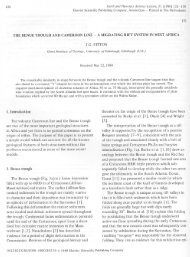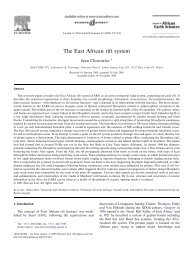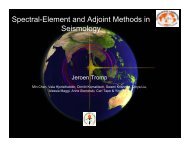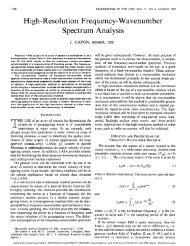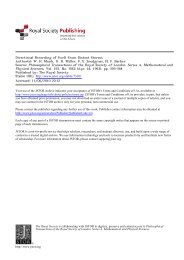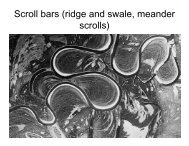Fluid Dynamics of a Terrestrial Magma Ocean - NMSU Geophysics ...
Fluid Dynamics of a Terrestrial Magma Ocean - NMSU Geophysics ...
Fluid Dynamics of a Terrestrial Magma Ocean - NMSU Geophysics ...
You also want an ePaper? Increase the reach of your titles
YUMPU automatically turns print PDFs into web optimized ePapers that Google loves.
328 Origin <strong>of</strong> the Earth and MoonThis gives velocities around 16 m/s with the uncertainty <strong>of</strong>a factor <strong>of</strong> 3. A moderate value <strong>of</strong> 10 m/s is used in theestimates below (Table 1).6. HEAT FLUXIn the early stages <strong>of</strong> crystallization, when the surfacetemperature is high, the atmosphere is presumably a “silicate”one (Thompson and Stevenson, 1988) and the heat fluxcan be calculated with the help <strong>of</strong> the blackbody modelFr=σ T4 (12)B swhere T s is the surface temperature and σ B = 5.67 ×10 –8 J m –2 K –4 is the Stefan-Boltzmann constant.This heat flux must match the heat flux transported tothe surface by convection. The convective heat flux dependson whether convection is in the regime <strong>of</strong> “s<strong>of</strong>t” turbulenceor “hard” turbulence. In the “s<strong>of</strong>t” turbulence regimewhereFs<strong>of</strong>t( )k T−Ts= 0.089H( )αgT−TsHRa =κν13 /Ra(13)3(14)is the Rayleigh number, T is the potential temperature, k isthe coefficient <strong>of</strong> thermal conductivity, κ = k/ρc p is the coefficient<strong>of</strong> thermal diffusivity, and ν = η/ρ is the kinematicviscosity (Kraichnan, 1962; Siggia, 1994).In the “hard” turbulence regime (Shraiman and Siggia,1990; Siggia, 1994)Fhard( ) − −k T−Ts= 022 . Ra PrH2/ 7 1/ 7 3/7λ (15)where Pr = ν/κ is the Prandtl number and λ is the aspectratio for the mean flow. The exact value <strong>of</strong> λ is unknownfor spherical geometry but is probably <strong>of</strong> the order <strong>of</strong> unity.Figure 4 shows that during the initial period <strong>of</strong> crystallization,when the temperature <strong>of</strong> the magma ocean is highand convection is in the “hard” turbulence convection regime,the heat flux is close to 10 6 W m –2 . During the lateststages <strong>of</strong> crystallization (upper mantle) the surface temperaturedrops below 1500 K and the heat flux decreases to 10 2 –10 3 W m –2 due to a greenhouse effect (Abe and Matsui,1986; Zahnle et al., 1988; Kasting, 1988). In the “hard”turbulence regime and for η l = 0.1 Pa s this does not happenuntil almost a complete crystallization <strong>of</strong> the magmaocean.7. CONDITIONS FOR EQUILIBRIUMCRYSTALLIZATION7.1. “Sufficient” Condition for EquilibriumCrystallizationIn this section we are concerned with the early crystallization<strong>of</strong> the magma ocean, before the crystal fractionreaches the rheological transition.Surface heat flux, W/m 210 710 610 5‘‘S<strong>of</strong>t’’ turbulence‘‘Hard’’ turbulence0.10.11010(a)Surface temperature, K22002000180016001400120010000.1‘‘S<strong>of</strong>t’’ turbulence‘‘Hard’’ turbulence0.11010(b)10 41600 1800 2000 2200 2400Potential temperature, K8001600 1800 2000 2200 2400Potential temperature, KFig. 4. (a) Surface heat flux and (b) surface temperature are shown as functions <strong>of</strong> the potential temperature, the convective regime(“s<strong>of</strong>t” vs. “hard” turbulence), and the viscosity <strong>of</strong> magma (0.1–10 Pa s).




